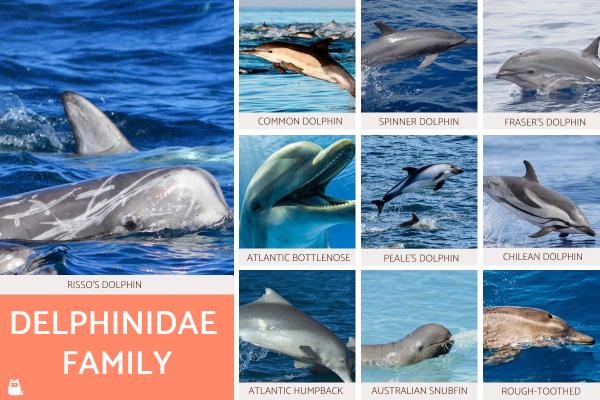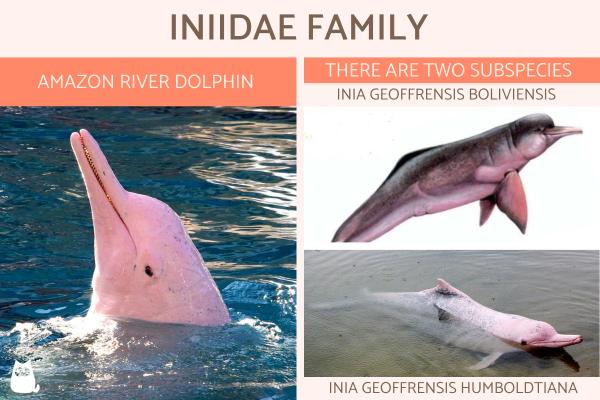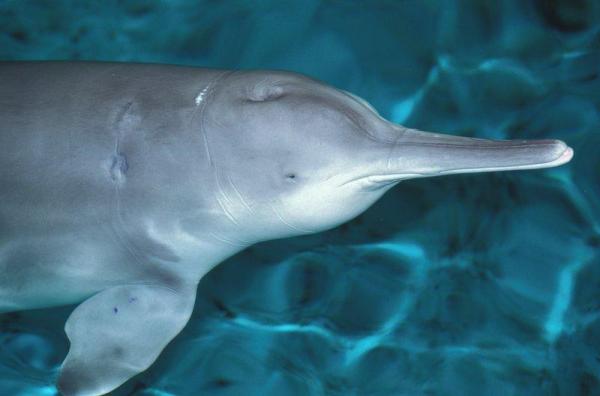
There are many species of cetaceans, which are divided into two major groups: Mysticetes, which have beards, and Odontocetes, which have teeth. There are several families of dolphins, and most of them are distinguished by their social skills, even with humans, and by their striking way of communicating. Because of their unique behaviors, dolphins are considered highly intelligent.
In this AnimalWised article, you will learn everything you need to know about the different types of dolphins.
Family Delphinidae
This dolphin family includes not only the species commonly referred to as dolphins, but also toothed whales, which include killer whales. The general characteristics of this family of dolphins include:
- They form a taxonomically diverse group, making them the largest family of cetaceans.
- Their size varies from 5 feet (1.52 m) to about 32.8 feet (10 m).
- Their weight ranges from 50 kg (ca. 110 lb) to 7,000 kg (ca. 15,432 lb).
- Males are generally larger than females.
- The presence of some type of elongated snout is common.
- Although they all have a structure known as the melon, which is made of fatty tissue and is used for communication and echolocation, in some the forehead protrudes thanks to this organ.
- The bodies are torpedo-shaped and streamlined.
- They usually have more or less uniform colors.
- They are carnivores and feed mainly on fish.
- They live exclusively in marine habitats.
Some species of the Delphinidae family and their conservation status
Some of the species that make up the Delphinidae family are the following. In addition, we also mention the conservation status of each type of dolphin according to International Union for Conservation of Nature (IUCN).
- Risso's dolphin (Grampus griseus) – Least concern.
- Common Dolphin (Delphinus capensis) – Least Concern.
- Spinner dolphin (Stenella longirostris) – Least concern.
- Fraser's dolphin (Lagenodelphis hosei ) – Least concern.
- Common bottlenose dolphin (Tursiops truncatus) – Least concern.
- Peale's dolphin (Lagenorhynchus australis) – Least concern.
- Chilean dolphin (Cephalorhynchus eutropia) – Near Threatened.
- Atlantic Humpback Dolphin (Sousa teuszii) – Critically Endangered.
- Australian snubfin dolphin (Orcaella heinsohni) – Vulnerable.
- Rough-toothed dolphin (Steno bredanensis) – Least concern.
If you are interested in learning more about dolphins, keep reading this article on dolphin mating and reproduction.

Family Iniidae
This family is taxonomically controversial, but we are guided by the International Union for the Conservation of Nature and the Integrated Taxonomic Classification System. Both recognize the existence of a genus with one species, the Amazon River dolphin (Inia geoffrensis) and two subspecies: Inia geoffrensis boliviensis and Inia geoffrensis humboldtiana. Both species are currently classified as endangered.
Characteristics of the species include:
- It inhabits freshwater ecosystems in the Amazon and Orinoco river basins.
- It is the largest of the river dolphin species, reaching a size of about 8.2 ft (2.5 m) and weighing nearly 462 lbs (210 kg).
- It exhibits a pronounced sexual dimorphism, and one of the most distinct among cetaceans, as males are larger.
- When young they are dark gray, but as they get older they turn pink, with the males having a more intense tone.
- It feeds on a wide variety of fish.
If you are interested in learning more about dolphins, keep reading this article on how do dolphins breathe underwater?

Family Lipotidae
There is only one species in this family, commonly known as Baiji (Lipotes vexillifer), a species of dolphin found only in China. Based on the last sighting in 2002, the species is considered endangered or possibly extinct.
- It is a freshwater dolphin.
- The body is streamlined and arched.
- It has an elongated snout.
- Coloration is bluish-gray with a white ventral side.
- Weight ranges from 88 pounds (39.92 kilogram) to 374 pounds (169.64 kg).
- Length varies from 45 feet (13.72 meters) to 82 feet (24.99 m).
- Their diet is virtually all fish.
If you are interested in learning more about dolphins, keep reading this article 10 fun facts about dolphins.

Family Platanistidae
South Asian river dolphins are two species of toothed whales in the genus Platanista. Both species of the genus are threatened with extinction. The two species were considered separate species until 1998, when the classification changed from two separate species to subspecies. However, recent studies have shown that they are separate species, so they have been reclassified.
Its main characteristics are:
- Its long snout stands out, which can reach up to 20% of the total body size. It measures up to about 8 in (21 cm), is relatively flat, widens at the tip and is slightly curved upwards.
- Sexually mature females have longer bills than males.
- It has 70 or more teeth, which are visible even when the mouth is closed.
- They are gray to brown, darker on the back than on the belly, and may have a pink underside.
- They weigh from 110 pounds (49.9 kg) to 198 pounds (89.81 kg) and grow from 6.5 feet (1.98 meters) to 13.1 feet (4 m) long.
- They are purely carnivorous, and in fact are the primary predators in their habitat, where they consume mainly fish, but also crustaceans and mollusks.

Family Pontoporiidae
It corresponds to a species of dolphin commonly known as La Plata dolphin, franciscana or toninha (Pontoporia blainvillei). It is an endemic species in Argentina, Brazil, and Uruguay and is classified as endangered by the International Union for Conservation of Nature (IUCN).
Its main characteristics include:
- Its snout is long and somewhat narrow.
- They are smaller than other dolphin species and grow between 2.3ft (0.7 m) and 5.5ft (1.68 m) long.
- As for their body mass, they weigh between 25 kg (55lbs) and about 32 kg (70.5 lbs).
- Males are smaller than females.
- It has one of the highest growth rates among cetaceans, although this is a particular characteristic of females.
- On the back, they can be brown to gray, while the ventral side is lighter.
- Their diet is specialized in fish and aquatic invertebrates.
- It lives in coastal marine ecosystems with turbid or clear water, and possibly in estuaries.
Several species of dolphins have been captured and trained to perform in shows in parks and zoos. These are animals in the wild. They must be allowed to remain in their natural habitat unless they are rescued following an accident. We at AnimalWised urge you not to visit facilities where these animals are kept for entertainment purposes.
If you are interested in learning more about dolphins, keep reading this article on why do dolphins jump out of water?

If you want to read similar articles to Different Species of Dolphins - 18 Types and Photos, we recommend you visit our Facts about the animal kingdom category.
- da Silva, V., Trujillo, F., Martin, A., Zerbini, AN, Crespo, E., Aliaga-Rossel, E. & Reeves, R. (2018). Inia geoffrensis . The IUCN Red List of Threatened Species Available at: https://dx.doi.org/10.2305/IUCN.UK.2018-2.RLTS.T10831A50358152.en.
- ITC. (2021). Inia geoffrensis . Available at: https://www.itis.gov/servlet/SingleRpt/SingleRpt?search_topic=TSN&search_value=180407#null
- Animal Diversity Web. (2020). Available at: https://animaldiversity.org/
- IUCN. (2022). The IUCN Red List of Threatened Species . Version 2021-3. Available at: https://www.iucnredlist.org
- ITC. (2021). Odontoceti . Available at: https://www.itis.gov/servlet/SingleRpt/SingleRpt?search_topic=TSN&search_value=180404#null